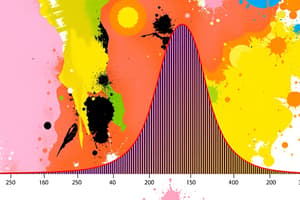Podcast
Questions and Answers
Which of the following statements best describes how variance relates to standard deviation?
Which of the following statements best describes how variance relates to standard deviation?
- Variance and standard deviation are unrelated measures of dispersion.
- Variance is the square root of the standard deviation.
- Standard deviation is the inverse of the variance.
- Standard deviation is the square root of the variance. (correct)
Events A, B, and C are collectively exhaustive. Which of the following statements must be true?
Events A, B, and C are collectively exhaustive. Which of the following statements must be true?
- The union of A, B, and C covers the entire sample space. (correct)
- Events A, B, and C must be independent.
- The intersection of A, B, and C must be empty.
- The probability of each event must be equal.
Given events X = {1, 3, 5} and Y = {3, 5, 7}, which of the following represents the intersection of X and Y?
Given events X = {1, 3, 5} and Y = {3, 5, 7}, which of the following represents the intersection of X and Y?
- {1}
- {1, 3, 5, 7}
- {}
- {1, 7}
- {3, 5} (correct)
The average score on an exam is 80 with a standard deviation of 5. Assuming a normal distribution, approximately what percentage of students scored between 70 and 90?
The average score on an exam is 80 with a standard deviation of 5. Assuming a normal distribution, approximately what percentage of students scored between 70 and 90?
If the covariance between two variables is 0, what can be concluded about their correlation?
If the covariance between two variables is 0, what can be concluded about their correlation?
A researcher is analyzing customer satisfaction scores for a particular product. They notice that a few customers have given extremely low scores, significantly lower than the majority. Which measure of central tendency will be most affected by these outlier scores?
A researcher is analyzing customer satisfaction scores for a particular product. They notice that a few customers have given extremely low scores, significantly lower than the majority. Which measure of central tendency will be most affected by these outlier scores?
In a study examining the relationship between hours of sleep and exam performance, a researcher collects data on both variables from a sample of college students. The researcher then uses this sample data to make generalizations about the entire population of college students. What type of statistical analysis is exemplified in this scenario?
In a study examining the relationship between hours of sleep and exam performance, a researcher collects data on both variables from a sample of college students. The researcher then uses this sample data to make generalizations about the entire population of college students. What type of statistical analysis is exemplified in this scenario?
A company wants to visually represent the distribution of its sales across different product categories. Which graphical tool is most appropriate for displaying the relative frequency of each product category?
A company wants to visually represent the distribution of its sales across different product categories. Which graphical tool is most appropriate for displaying the relative frequency of each product category?
Suppose you are analyzing the prices of a particular stock over the last 5 years. This data is best described as:
Suppose you are analyzing the prices of a particular stock over the last 5 years. This data is best described as:
What is the correct notation to represent two events, A and B, as independent events?
What is the correct notation to represent two events, A and B, as independent events?
A researcher wants to investigate the effects of a new fertilizer on crop yield. They divide a farm into several plots, apply the fertilizer to some plots, and leave others untreated as a control. What is the population in this scenario?
A researcher wants to investigate the effects of a new fertilizer on crop yield. They divide a farm into several plots, apply the fertilizer to some plots, and leave others untreated as a control. What is the population in this scenario?
A store manager finds that 60% of customers purchase coffee, 30% purchase a pastry, and 10% purchase both. Are the events 'purchasing coffee' and 'purchasing a pastry' mutually exclusive? Explain.
A store manager finds that 60% of customers purchase coffee, 30% purchase a pastry, and 10% purchase both. Are the events 'purchasing coffee' and 'purchasing a pastry' mutually exclusive? Explain.
A student scores 80 on a math exam. The mean score for the exam is 70, and the standard deviation is 5. What is the student's Z-score?
A student scores 80 on a math exam. The mean score for the exam is 70, and the standard deviation is 5. What is the student's Z-score?
Flashcards
Mutually Exclusive Events
Mutually Exclusive Events
Events that cannot occur at the same time. If one event happens, the other cannot.
Descriptive vs. Inferential Statistics
Descriptive vs. Inferential Statistics
Describes data (mean, median, mode) or draws inferences (predictions, hypotheses).
Population
Population
The entire group you want to know about.
Quantitative vs. Qualitative Data
Quantitative vs. Qualitative Data
Signup and view all the flashcards
Frequency
Frequency
Signup and view all the flashcards
Outliers Influence Which Statistic the Most?
Outliers Influence Which Statistic the Most?
Signup and view all the flashcards
Time Series Data
Time Series Data
Signup and view all the flashcards
Statistic
Statistic
Signup and view all the flashcards
Empirical Rule
Empirical Rule
Signup and view all the flashcards
Dispersion
Dispersion
Signup and view all the flashcards
Variance
Variance
Signup and view all the flashcards
Collectively Exhaustive Events
Collectively Exhaustive Events
Signup and view all the flashcards
Union (Probability)
Union (Probability)
Signup and view all the flashcards
Study Notes
- Exam 1 includes 40 questions to be answered in 50 minutes.
- The exam is in person and on paper; a scantron will be provided.
- Mutually exclusive events should be understood with examples.
Branches of Statistics
- The two branches of statistics are: descriptive and inferential.
Independent Events Notation
- Notation for two independent events should be understood.
Z-Score
- A Z-score includes characteristics, formula, and calculation with given numbers.
Population vs Sample
- Population definition including how a sample differs from a population should be understood.
- Examples of population and its corresponding sample should be practiced.
Variable Data
- Examples differentiating quantitative vs. qualitative variables/data should be understood.
- Examples differentiating descriptive vs. inferential data should be understood.
Data Subset
- Reasons for subsetting data should be understood.
Horizontal Bar Chart
- The process of creating a horizontal bar chart should be understood.
- The appropriate graphical tool should be used to display the relative frequency of a numerical variable.
Frequency
- Understanding, finding, and defining frequency is key.
- The ability to find relative frequency from a frequency table should be understood.
- The process of finding relative frequency should be understood.
- The difference between relative frequency and percent frequency should be understood.
Budget Allocation
- Calculation of spending given budget percentages is relevant.
- For instance, spending 35% of a weekly food budget with a $200 monthly budget requires calculation.
Observation Proportion
- Determining the proportion of observations within a specified range requires calculation.
- For example, determining the proportion of observations at least 18 but less than 24.
Statistics and Outliers
- Recognizing the statistic most influenced by outliers is important.
Probability Calculation
- Probability calculations involving customer preferences need to be understood.
- For instance, calculation of randomly selected customer's beer order probability at a local bar.
Camera Brand Probability problem
- Determining probability from a table using conditional probability.
- Given that a camera purchase was at Amazon.com, calculate the probability it was a Canon brand.
Data Types
- Understanding types of data and knowing the difference btwn time series data and cross-sectional data.
Statistics Definition
- Definition of a statistic should be known.
Mean, Median, and Mode
- Understanding mean, median, and mode, including which is most influenced by outliers, is required.
Frequency Case Study
- Use a table to take a statistic like a percent or relative frequency
- Find the number given the population size by remembering the relative frequency case study.
Empirical Rule
- The empirical rule should be understood.
Dispersion Statistics
- Knowing the most common statistics to show dispersion is necessary.
Variance
- Understanding variance, what it shows, and its relation to standard deviation is important.
Covariance
- Definition of covariance.
Collectively Exhaustive Event
- How an event can be collectively exhaustive should be understood.
Union in Probability
- Definition of a union in probability and recognize the notation.
Intersection in Probability
- Understanding of the intersection of 2 events in probability notation.
- The intersection of events A = {The Porch, Louie's, The Library, O'Connell's} and B = { The Library, O'Connell's, Logies, Volare} is {The Library, O'Connell's}.
- The union of events A = {The Porch, Louie's, The Library, O'Connell's} and B = { The Library, O'Connell's, Logies, Volare} is {The Porch, Louie's, The Library, O'Connell's, Logies, Volare}.
Probability Summation
- All probabilities must add up to 1.
Event Outcomes
- When an event has one outcome, it is an elementary event.
Sample Space
- Understanding of sample space should be there.
- Determine the sample space for letter grades in a class.
Complement of A
- Understanding of the complement of A given sample space S is required.
Correlation Coefficient
- Correlation coefficient formula and calculation should be understood.
Standard Deviation
- Deriving standard deviation from variance should be understood.
Exam Score Probability
- Determining exam score probability given average and standard deviation.
- Knowing if the average on exam 1 is an 85 with a standard deviation of 1.5, what is the probability you score less than 75.
- What is the probability you score greater than a 90?
Studying That Suits You
Use AI to generate personalized quizzes and flashcards to suit your learning preferences.



